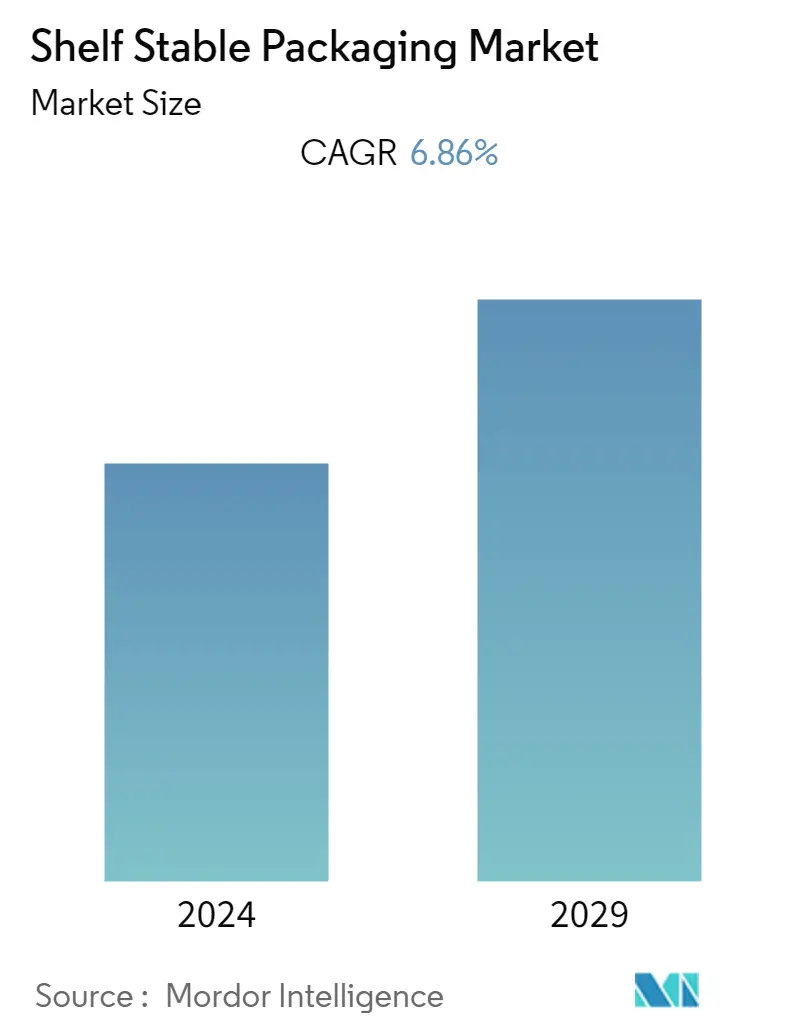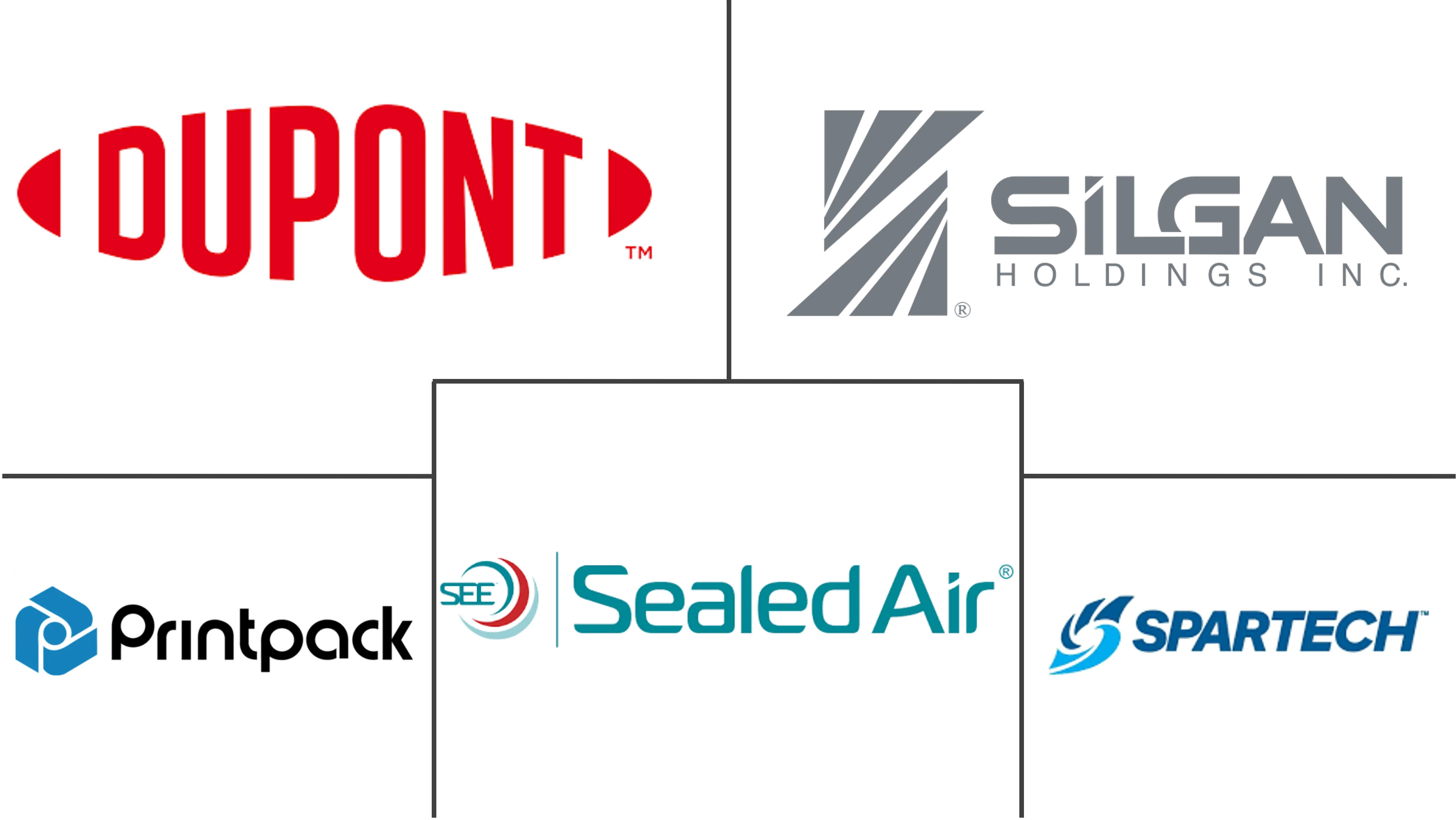Market Size of Shelf Stable Packaging Industry

| Study Period | 2019 - 2029 |
| Base Year For Estimation | 2023 |
| CAGR | 6.86 % |
| Fastest Growing Market | Asia-Pacific |
| Largest Market | Asia-Pacific |
| Market Concentration | Medium |
Major Players
*Disclaimer: Major Players sorted in no particular order |
Shelf Stable Packaging Market Analysis
The Shelf Stable Packaging Market is expected to record a CAGR of 6.86% during the forecast period. The perceptions of packaging among consumers have changed as a result of the COVID-19 pandemic. The number of consumers choosing packaged goods with a longer shelf life has increased. Additionally, COVID-19-related worries about food safety increased the demand for packaged foods, and it is anticipated that this trend will continue in the post-COVID market conditions as well.
- Rising demand for packaged food and beverages, increasing demand for Ready-to-Eat (RTE) food, the convenience of use, and increasing cost-effectiveness of shelf-stable packaging are primary factors supporting the market growth of the market worldwide.
- Climatic conditions and higher cost of refrigeration facilities are some of the major factors that are influencing packaging organizations to invest in packaging technologies that can improve the shelf life of products such as milk, value-added dairy products, food, and beverages.
- The novel food packaging techniques, viz. active packaging, intelligent packaging, and bioactive packaging, which involve intentional interaction with the food or its surroundings and influence on consumer's health, have been the major innovations in the field of packaging technology. These novel techniques act by prolonging the shelf life, enhancing or maintaining the quality, providing an indication, and regulating the freshness of food products.
- According to the 2022 PMMI State of the Industry, it has never been more crucial for packaging to be closed and sealed properly due to stricter health and safety regulations and producers looking to extend the shelf life of their products.
- All stakeholders benefit from increased shelf life. Processors frequently increase sales by expanding distribution to new markets. A sellable product can stay on store shelves for a longer period of time if it has a longer shelf life, which allows retailers to reduce the frequency of restocking and the losses caused by out-of-date products. Extended shelf life makes it simpler for consumers to keep a stocked pantry. Additionally, it lessens the quantity of food that is thrown away.
- COVID-19 has negatively impacted the market as the demand for food and beverage has witnessed growth, which has supported the market growth.
Shelf Stable Packaging Industry Segmentation
The market size reflects the value of shelf-stable packaging products packed with technologies such as aseptic food packaging, retort food packaging, hot fill food packaging, and more.
The shelf-stable packaging market is segmented by packaging format (flexible, rigid), packaging material (plastic, metal, glass, paper and paperboard), product type (metal cans, bottles, jars, cartons, pouches), packaging technology (sauce & condiment, processed fruit & vegetable, prepared food, juice, dairy food, meat poultry & seafood), and geography. The market sizes and forecasts are provided in terms of value (USD million) for all the above segments.
| By Packaging Format | |
| Flexible | |
| Rigid |
| By Packaging Material | |
| Plastic | |
| Metal | |
| Glass | |
| Paper and Paperboard |
| By Product Type | |
| Metal Cans | |
| Bottles | |
| Jars | |
| Cartons | |
| Pouches | |
| Other Product Type (Bag in Box, Cups, Trays, Bowls, etc) |
| By Packaging Technology | |
| Asceptic Food Packaging | |
| Retort Food Packaging | |
| Hot Fill Food Packaging | |
| Others |
| By End User Industry | |
| Sauce & Condiment | |
| Processed Fruit & Vegetable | |
| Prepared Food | |
| Juice | |
| Dairy Food | |
| Meat Poultry and Seafood | |
| Others |
| Geography | |
| North America | |
| Europe | |
| Asia Pacific | |
| Latin America | |
| Middle East and Africa |
Shelf Stable Packaging Market Size Summary
The Shelf Stable Packaging Market is experiencing significant growth, driven by changing consumer perceptions and increased demand for packaged goods with extended shelf life, a trend accelerated by the COVID-19 pandemic. The market is supported by the rising popularity of Ready-to-Eat (RTE) foods, the convenience and cost-effectiveness of shelf-stable packaging, and innovations in packaging technologies such as active, intelligent, and bioactive packaging. These advancements not only prolong the shelf life of products but also enhance their quality and safety, addressing consumer health concerns. The market's expansion is further fueled by the need to reduce food waste and improve food preservation without relying on refrigeration or preservatives, particularly in regions with challenging climatic conditions and limited infrastructure.
In the Asia-Pacific region, the demand for retort pouch packaging is growing, driven by the need for convenient food and beverage solutions. Supermarkets and online stores are becoming key distribution channels, especially in developing countries like India and China, where fast distribution is crucial. However, challenges such as improper handling, lack of modern storage facilities, and long transportation times can affect product shelf life. The competitive landscape of the market is medium, with several key players focusing on product innovation and strategic partnerships to enhance their market position. Recent developments include acquisitions and collaborations aimed at improving packaging solutions and sustainability, highlighting the industry's commitment to addressing both consumer needs and environmental concerns.
Shelf Stable Packaging Market Size - Table of Contents
-
1. MARKET INSIGHTS
-
1.1 Market Overview
-
1.2 Value Chain Analysis
-
1.3 Porters Five Force Analysis
-
1.3.1 Threat of New Entrants
-
1.3.2 Bargaining Power of Buyers/Consumers
-
1.3.3 Bargaining Power of Suppliers
-
1.3.4 Threat of Substitute Products
-
1.3.5 Intensity of Competitive Rivalry
-
-
1.4 Assessment of the Impact of COVID-19 on the Market
-
-
2. MARKET SEGMENTATION
-
2.1 By Packaging Format
-
2.1.1 Flexible
-
2.1.2 Rigid
-
-
2.2 By Packaging Material
-
2.2.1 Plastic
-
2.2.2 Metal
-
2.2.3 Glass
-
2.2.4 Paper and Paperboard
-
-
2.3 By Product Type
-
2.3.1 Metal Cans
-
2.3.2 Bottles
-
2.3.3 Jars
-
2.3.4 Cartons
-
2.3.5 Pouches
-
2.3.6 Other Product Type (Bag in Box, Cups, Trays, Bowls, etc)
-
-
2.4 By Packaging Technology
-
2.4.1 Asceptic Food Packaging
-
2.4.2 Retort Food Packaging
-
2.4.3 Hot Fill Food Packaging
-
2.4.4 Others
-
-
2.5 By End User Industry
-
2.5.1 Sauce & Condiment
-
2.5.2 Processed Fruit & Vegetable
-
2.5.3 Prepared Food
-
2.5.4 Juice
-
2.5.5 Dairy Food
-
2.5.6 Meat Poultry and Seafood
-
2.5.7 Others
-
-
2.6 Geography
-
2.6.1 North America
-
2.6.2 Europe
-
2.6.3 Asia Pacific
-
2.6.4 Latin America
-
2.6.5 Middle East and Africa
-
-
Shelf Stable Packaging Market Size FAQs
What is the current Shelf Stable Packaging Market size?
The Shelf Stable Packaging Market is projected to register a CAGR of 6.86% during the forecast period (2024-2029)
Who are the key players in Shelf Stable Packaging Market?
Sealed Air Corporation, Spartech Corporation, Printpack, Silgan Holdings and DuPont are the major companies operating in the Shelf Stable Packaging Market.

